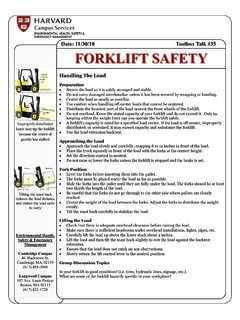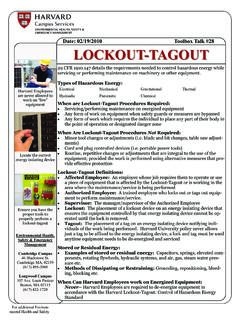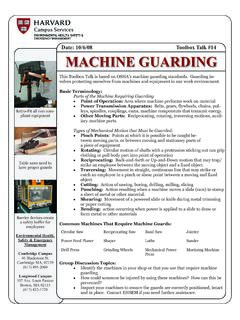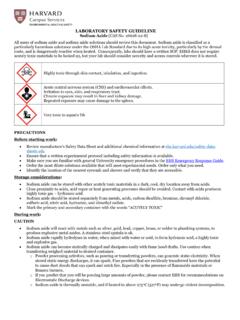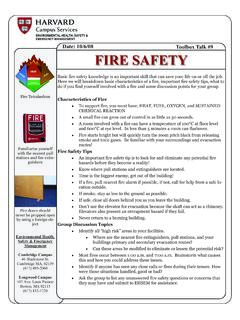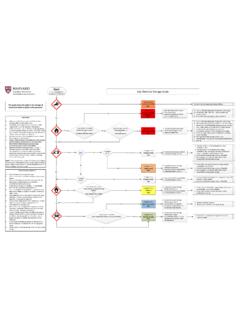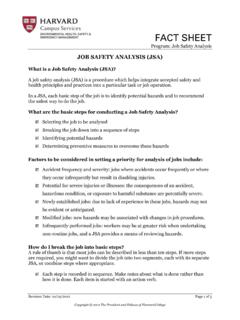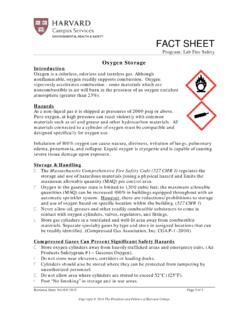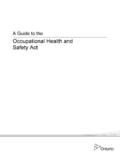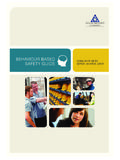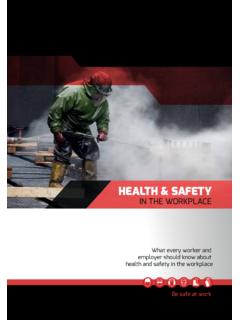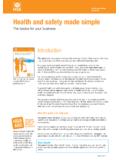Transcription of FACILITY & BUILDING MANAGERS ENVIRONMENTAL HEALTH …
1 ENVIRONMENTAL HEALTH & safety REFERENCE guide FACILITY & BUILDING MANAGERS ENVIRONMENTAL HEALTH & safety REFERENCE guide FACILITY & BUILDING MANAGERS are required to have a wide range of working knowledge to operate their facilities safely and to meet the expectations of their various customers. The intent of this guide is to provide information on common FACILITY related emergencies, as well as, guidance to insure compliance with OSHA, EPA , NFPA statues/regulations, and or Harvard University best practices. The Department of ENVIRONMENTAL HEALTH & safety is built on a model of service developed in collaboration with University partners and delivered through a tailored approach that addresses school and department specific preparedness, safety and compliance needs. This guide will provide quick reference to the EH&S web sites, external resources, checklist and other helpful references. If you have any questions, please contact your Designated safety Officer (DSO) or ENVIRONMENTAL HEALTH & safety (EH&S) for assistance.
2 ENVIRONMENTAL HEALTH & safety REFERENCE guide 2 TABLE OF CONTENT TOPIC PAGE EH&S Organization 3 Emergencies & Incident Management 4 Emergency Management 5 Accident Reporting & Investigations 6 Automated External Defibrillators (AEDs) 7 Facilities & Occupational safety Group 8 Fire safety & Evacuation Plans 9 - 10 Event & Event Planning 11 Service Contractor safety 12 Construction & Renovations 13 Hazardous BUILDING Materials 14 Confined Spaces 15 Electrical safety /70E/Lockout Tagout 16 Indoor Air Quality (IAQ) 17 Floods 18 Fall Protection 19 Hazardous Waste Management 20 Oil Storage/Management 21 Wastewater & Storm Water 22 Air Emissions 23 Machine Shops 24 Cranes/Hoists 25 Pest Management 26 - 27 Drinking Water Quality 28 - 29 Communicable Disease 30 Food safety 31 - 32 Key Contacts & Resources 33 Accidents 34 Working Fire 35 - 36 Asbestos Release Response 37 Flood Response Checklist 38 - 39 ENVIRONMENTAL HEALTH & safety REFERENCE guide 3 OUR ORGANIZATION We support the University s mission of teaching and research by promoting a culture of safety , HEALTH , ENVIRONMENTAL protection, and emergency preparedness.
3 Our customers include students, faculty, and staff, as well as the broader community and environment around us. We strive to understand our customers and develop services specific to their needs in four primary areas Buildings & Facilities, Laboratories, Emergency Management, and Project Support. The challenge of providing these services requires us to operate as a cross-functional team, finding creative ways to provide service excellence and ensure compliance with laws, regulations, and University policies. ENVIRONMENTAL safety AND COMPLIANCE OFFICERS (ESCO S) Key components of the management structure include an ENVIRONMENTAL safety and Compliance Committee (ESCO), chaired by the Managing Director of EH&S and comprised of senior administrators from major schools and departments, EH&S, and a network of ENVIRONMENTAL and safety Compliance Officers (ESCOs). ESCOs are appointed by the dean or vice-president of each operating unit to implement, manage and enforce ENVIRONMENTAL and safety programs.
4 ESCOs act as the primary point of contact with EH&S and work closely with EH&S staff to identify local priorities and coordinate EH&S service delivery. The responsible unit is accountable for fines or penalties resulting from noncompliance, a model supported by the deans and University administration. Committees in which EH&S plays a leadership, management or strong supporting role include. safety COMMITTEES In addition, EH&S staff participate in local safety committees established by various schools and departments (SEAS, FAS, HMS, SPH, etc.) These committees typically meet on a monthly basis and are used for information exchange, incident analysis, consensus BUILDING and compliance oversight. EH&S is an active member of local and national groups engaged in regulatory reform, technical development and exchange. ENVIRONMENTAL HEALTH & safety (EH&S) ENVIRONMENTAL HEALTH & safety REFERENCE guide 4 REPORTING EMERGENCIES: Life Threatening Emergencies: Medical, Fire, Police: CALL 911 Harvard University Police: (617) 495-1212 University Operations Center: (617) 495-5560 HMS/HSDM Control Center: (617) 432-1901 URGENT EVENTS Accidents Medical Emergencies Evacuation of Facilities or Campus Security Threat Fire Floods Loss of Power Hazardous Material Release Uncontrolled Chemical Release Natural Gas Odor EMERGENCIES & INCIDENT MANAGEMENT ENVIRONMENTAL HEALTH & safety REFERENCE guide 5 Emergency Management works with central departments, including the Harvard University Police Department (HUPD), Harvard Public Affairs & Communications (HPAC), University HEALTH Services (UHS), and others to coordinate the University s emergency mitigation, planning, preparedness, response and recovery efforts.
5 Emergency Management provides direct support to Harvard s schools and departments in planning for and responding to emergencies. Emergency Management has designed an emergency structure that is scalable to the needs of the emergency. It consists of school and department Local Emergency Management Teams (LEMTs), Central Administration Emergency Support Functions (ESFs), and a University-wide Crisis Management Team (CMT). During an emergency, BUILDING MANAGERS need to Assess - Consult - Execute the situation to help eliminate or mitigate the hazards. ASSESS - CONSULT- EXECUTE Coordinate your emergency planning, preparedness and response efforts with your school or departments Local Emergency Management Team (LEMT) or Emergency Support Function (ESF). Update your BUILDING procedures ( Fire, Loss of Power, Flood, Utility failure, etc.) in the Facilities Incident Notification System (FINS). Contact the University Operations Center at 617-495-5560 for support.
6 Register for MessageMe at to receive emergency alerts from the University by text, voice and email. Prepare before severe weather events, prepare your FACILITY by testing emergency equipment and systems, clearing debris, securing outdoor equipment, and closing windows and doors. Emergencies - establish a secure or safe area, block-off hazardous areas, keep tenants informed of FACILITY / safety issues, provide status updates to your LEMT/ESF and to the University Operations Center (617-495-5560). Personal safety is most important. Exercise caution at all times. EH&S experts are available to 24/7 to support ongoing EH&S-related emergencies by calling University Operations Center (617-495-5560) or the EH&S main phone line (617-495-2060). EMERGENCY ALERTS: 617-496-NEWS (6397) EMERGENCY MANAGEMENT ENVIRONMENTAL HEALTH & safety REFERENCE guide 6 Harvard University employees must complete an Injury/Illness Accident Report Form within 24 hours of a work related injury or illness.
7 ALL work related injuries and illnesses must be reported. Accident report forms can be obtained from Human Resources, your Supervisor; return Harvard Injury and illness/Accident report to your supervisor to complete and sign. Completed Harvard Injury/illness Accident reports are then submitted to Human Resources by the Supervisor. Human resources will forward a copy to the third party administrator and ENVIRONMENTAL HEALTH and safety (EH&S) for review. Harvard must report the following to the Federal Occupational safety and HEALTH Administration (OSHA): All work related fatalities within 8 hours. Any work-related inpatient hospitalizations, amputations, or loss of eye must be reported within 24 hours. Injuries and illnesses that involve one of the aforementioned must be immediately reported to the Operations Center (617-495-5560). Harvard EH&S will begin an initial investigation of the incident and make the appropriate notifications on behalf of the institution.
8 ASSESS - CONSULT- EXECUTE 911 should be called for MEDICAL and FIRE emergencies. All incidents that resulted in injury must be reported on the Harvard Injury/illness Accident report. Serious injuries/illnesses must be reported to the Operations Center immediately after contacting 911 or emergency personnel. Immediately report work related Injuries/illnesses that involve a serious injury, any inpatient hospitalization of an employee, an amputation , the loss of an eye, or a fatality to the Operations Center. Contact EH&S for assistance with serious accidents/incidents investigations. In some case, it is important to safe guard the area of the accident, secure equipment and consult with EH&S. Ensure that all accidents/incidents that occur in your FACILITY are promptly reported and investigated by filling out a Harvard Injury/Illness Accident report and submitting it to Human Resources. ACCIDENT REPORTING & INVESTIGATIONS ENVIRONMENTAL HEALTH & safety REFERENCE guide 7 EH&S, in collaboration with University HEALTH Services (UHS), has developed an Automated External Defibrillator (AED) standard for Harvard's Schools and Departments to implement a Public Access Program (PAD).
9 EH&S provides services and on-line tools to assist in the development and maintenance of local AED programs. EH&S assists schools and departments with determining the number of AEDs needed, location to store the AED, coordinating the purchase of the AED and answer any technical questions the client may have. AEDs are medical devices used during cardiac emergencies, and can be found in many Harvard buildings. Massachusetts General Law ( Ch. 93, Section 78A) requires that AEDs be present in HEALTH clubs and athletic facilities. Harvard s AED program is not mandatory in non - athletic facilities, but if a FACILITY does participate, it must adhere to the University policy. ASSESS - CONSULT- EXECUTE If your FACILITY has AEDs, you must comply with Harvard s AED program. Harvard s AED program follows the American Heart Association s (AHA) Public Access to Defibrillation (PAD) guidelines. Medical oversight - AED programs must have authorization from the AED Medical Director, located in University HEALTH Services.
10 The responsibilities of the Medical Director include; reviewing the purchase of all AEDs, submitting necessary records and information to local EMS offices, and conducting post incident reviews. Inspections - AEDs are required to be inspected on a monthly basis to ensure sufficient battery power, non-expired electrode pads, and the AED software is operating properly. A record of the inspection must also be maintained. Depending on your location and specific access controls, EH&S can conduct and track your monthly inspections. Training - At least one full time employee in your BUILDING or work area needs to maintain a current CPR/AED training certification to be compliant with PAD guidelines. The two most common training organizations are the American Red Cross and the American Heart Association-both training organizations meet the definition of qualified training. AUTOMATED EXTERNAL DEFIBRILLATORS (AEDs) ENVIRONMENTAL HEALTH & safety REFERENCE guide 8 The Facilities and Occupational safety group anticipates and plans for occupational, FACILITY and life safety risks for planned and unplanned events at Harvard University.
